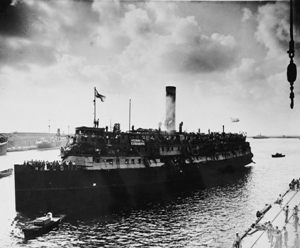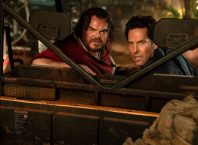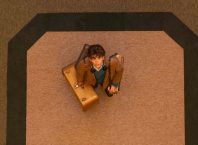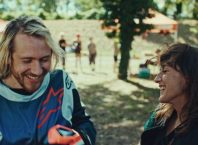Most of us think we know the story of the Exodus, after all, we’ve seen the movie, haven’t we? Though Paul Newman’s heroic visage is permanently etched on the collective memory, when it comes to the details, the picture becomes somewhat fuzzy – did the British finally let the ship of refugees enter the harbor at Haifa? Were they detained in Cypress? What really happened in 1947, and why should we care?
“4,500 people – it’s amazing that so many people were on the ship. It’s a huge number relative to 1947-48. Almost everyone in Israel knows someone who was on the ship. It’s as if all of Israel was on the Exodus,” says Uri Borreda, who with Itzik Lerner spent three and a half years creating Exodus – the True Story. The documentary film, based on extensive research and archival footage, tells the story of the Exodus through the personal narratives of three people who made the voyage as teenagers: Dani Avidar, Lili Carmon and Moshe Tyomkin. Following the November 29th broadcast of the movie on Channel 1 in Israel, Midnight East met with filmmaker Uri Borreda to discuss the film.
Ayelet Dekel: How did you become interested in making the film? Did you know the background to the story?
Uri Borreda: Few people know the story. They are usually ready to swear that the passengers of the Exodus were detained in Cypress. But it’s not true, they were never in Cypress. Even when they teach it in school, in citizenship classes about the illegal immigration (Ha’apala), you learn that there was a ship called Exodus and there was a battle with the British but no one emphasizes the importance of the events in relation to the 29th of November – the vote in the UN, the incident of the Exodus had a lot of impact. There are people who claim that [were it not for the Exodue] the State of Israel would have come into being, but certainly not in 1948.
For me, Exodus was the movie with Paul Newman, I love it, I’ve seen it ten times and I will probably see it again. One day at a family gathering, my aunt said to me – ‘you know, your uncle, your grandfather’s brother was on the Exodus.’ He was with a youth group from Marseille, waiting to immigrate and they joined the voyage. I thought: Let’s make a movie. I began researching the story and the more I opened it up and peeled off layers I realized that this was a huge, powerful story – the real story was far more dramatic and fascinating than the invented story. I felt that I needed someone to do it with me and approached a good friend, Itzik Lerner. I told him that I had an idea for a movie about the Exodus. Itzik replied: You’re kidding, my father came to Israel on the Exodus.
AD: Could you tell me more about your collaboration with Itzik?
UB: We both live in the south of Israel. We met when Itzik finished film school, about 20 years ago. We respect one another and consult with one another. Our opinions are fairly similar but we have a different narrative approach and we complete one another. Itzik is very interested in the personal story; I am more interested in creating a narrative, seeing the entire story as a structure. He’s strong on the details; I’m strong on the plot and action. I close my eyes and see the movie in my head; I can almost visualize it on the screen. I aim for that vision, and Itzik wants to dig down to the smallest, most minute detail, the most marginal, who knows if we will ever use it or need it, but we should have it. I am looking for my story and may miss a certain element because I won’t explore to the limit and Itzik is the opposite. It’s a collaboration that has stood the test of time.
AD: Aside from its historical significance, any Hollywood movie would be pressed hard to compete with the action, drama and emotionally intensity that this documentary delivers. How do you achieve that, and how did you decide to follow the narratives of these three – Avidar, Carmon and Tyomkin?
UB: We spent a lot on the research; we didn’t spare any expense on archival material. We have 100 hours of film; and have archival material from all over the world. We had a researcher in England, an Israeli woman living in France, someone in the US. All the money we raised went towards production costs.
[We felt that] It has to be a movie that stands on its own, not connected to the Holocaust, not connected to the Jews. It’s simply a story of three people and everything that that happens to them, the hardships they endure. To understand this story, it’s not enough to say that there were 4,500 miserable people on the deck; you need to understand where these people came from.
We arrived at the conclusion that we need to tell, not the story of the heroes of the Hagana and Palmach, they are heroes, they did amazing things – in 1946 they gathered 4,500 people from all over Europe, they crossed borders illegally and brought them all to the meeting place at a time when there were no cell phones, no computers, there was no FAX, you couldn’t send an SMS – but everyone made it there on the same day – even now it would be an impossible task to bring so many people to a particular place at the same time.
However, each one of those people spent only a small amount of time with them [the Exodus]. We realized the story of Exodus has to be told by the people who went through it all. That became our guideline, we decided that we need to find people who survived WWII, and endured all the hardships of the voyage, until the camps in Pfaffendorf, and made the entire journey. That was our first condition; the second was that they had to be healthy and strong enough to make it through this story with us. It’s not easy to spend a month in Europe with us, walking around with equipment from morning til night and to talk to the camera. It’s very hard. If the physical experience is difficult it is also very difficult emotionally. These are people who have lived through events that are impossible to describe.
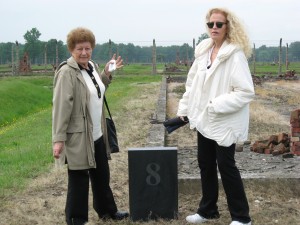
For example, Lili was in Auschwitz, she escaped the gas chamber 4 times. When we went there together to film that was the first time she entered the crematorium. Do you know what that was like for her? She almost fainted there; she almost died in our arms. She had seen the building from the outside [she could not have been inside and survived], she had seen the smoke and felt the stench [during the war], but when she saw the place she just broke down. She maintained her facon throughout the filming, but this was the first time she truly understood what had happened there, she saw it with her own eyes. In creating the movie we tried to enable each of the three to experience something that they had not experienced before.
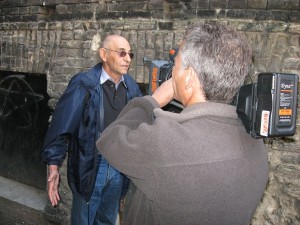
Dani Avidar had been taken to a concentration camp, but his family was taken to Ponar [mass killing site] and killed. He had never been there – had he been there, he would not have returned. We took him to Ponar and managed to find the place where his family was killed. The guard who maintains the site like a museum had dates on which Jews were evacuated from the Vilna Ghetto and the place where those Jews were killed. Dani Avidar knew the date of his parents’ evacuation from the ghetto. We found the place where they were probably buried, a mass grave, and we filmed Dani. Suddenly, he took a bag of earth from his pocket, we didn’t know he had brought it, and said, “I brought dirt from my home,” and scattered it on the mass grave.
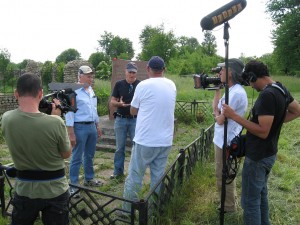
Moshe Tyomkin had escaped from the mass killing sites to a small village where his father’s family lived and there he hid in a basement. They killed everyone and bodies fell on him. He was 11 years old. His mother was murdered there. His father was not in the village that day; he had gone to look for food. Moshe lay there for 24 hours with the bodies on top of him until a family member arrived and found him and brought him to his father. He joined the partisans with his father, but never knew what had become of his mother. We brought him to the mass grave where his mother is buried. It’s the first time he saw the place.
To make the experience more meaningful for the viewers, so that they will understand the implication of returning these Jews to Germany, we showed the individual experience of each of the three, what it meant to each one to return there [to Europe]. We interviewed 150 people for the film. When we saw them [Avidar, Carmon and Tyomkin] we said – bingo.
I wanted to take things even farther. I wanted to re-enact the voyage. What would it do to these people to be on the water for a month? To spend time out at sea, only water all around, then suddenly seeing the shores, seeing Israel. We didn’t do it because of the cost. I should have insisted [on making the voyage], I regret it now. I wanted to bring the British to the voyage. There has never been a meeting between the Jews and British who were involved in the Exodus. Where could such a meeting take place if not on board ship? To bring the British to Marseille and let them experience the voyage together.
AD: The British testimony in the film made a strong impression on me. How did you find them?
UB: Josie found the British who were interviewed through the Royal Navy. They had a veterans club and she saw an ad in their newspaper about a 60 year reunion. We told them what we were looking for: someone who had taken part in the battle, someone who sent them away from Haifa, someone who made decisions. We divided the story into intersections: Germany and concentration camps, the South of France, Sette, the day of departure, the battle with the British, arrival in Haifa, expulsion, Porte de Beouf, Hamburg, the DP camps. We looked for people who were at each intersection, who had something to say about it.
With all this – no one wanted to give us funding. Suddenly Channel 1 said we will give you 50%. That gave us some breathing room. We said, at least we’ll film it, even if we can’t fund the editing. Then Ziv Naveh from Gesher said: I’ll help you. She did and also spoke to the Avi Chai Foundation and we had most of the money we needed. The Speilberg Archive at the Hebrew University understood the importance of the project and helped us enormously.
AD: Did you make use of reenactments?
UB: No, it’s all real. All the archival footage is precise and from the specific historical event except one scene: the battle scene. It is a real battle but it is not from the Exodus because no one filmed the Exodus. It is a battle that took place on a small boat that arrived previously. The ship was called the Unafraid, it happened in the same year – 1947. It is a boat of illegal immigrants, just not the Exodus. I discovered Ruth Gruber, I googled and found her. I bought the book and thought –this is a woman we have to talk to, but she must be so old…then I found out that not only is she alive – she’s coming to Israel. We received permission to film her. It was in March 2009 at the Har Zion hotel. No tricks. We left no stone unturned.
We have so much material – it was hard to leave things out. I’ll tell you one story. When the immigrants were sent away from the shores of Israel, there was no contact between the three ships. How do you let the people on the other ships know not to get off when the ship reaches shore? Someone needs to jump into the water. Micha Perry stayed on the boat; he didn’t get off in Haifa. He approached Noah Klinger and told him: you are the best swimmer, but I can’t tell you to jump. Noah jumped in the water and waited for a ship to pick him up. The ship arrived, then turned and disappeared, and he remained in the water. He thought: I survived Auschwitz in order to drown here and die. Suddenly he felt something hard – a wood ramp. He thought he was hallucinating. It was a minesweeper from one of the British ships. He was taken up on the ship. They didn’t know why he jumped, but they gave him a hero’s reception, they saluted him. They couldn’t understand why the Jews were fighting so hard. It’s an amazing story not in the movie. When they arrived at Porte de Boeuf, each ship had decided on its own that they would not leave the ship. You can’t invent a script like this.

